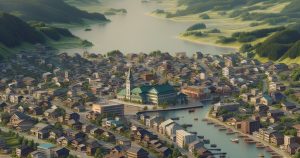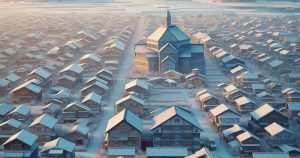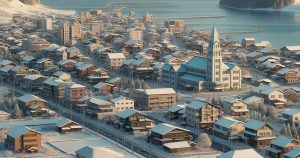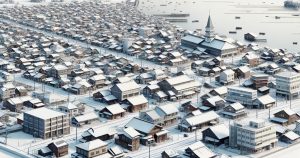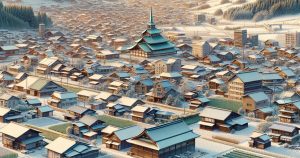| population | 18,039 peoples |
|---|---|
| area | 277.69 km² |
| population density | 65 peoples/km² |
Located in the central part of Hokkaido, the city of Bibai flourished as one of the key industrial hubs during Japan’s development period. From the Meiji era to the mid-Showa period, Bibai prospered as a major coal mining center, home to large-scale operations by Mitsubishi and Mitsui. At its peak, the population exceeded 90,000, and remnants of that golden age still remain across the city today. After the closure of its coal mines, Bibai successfully transformed itself, preserving its industrial heritage while cultivating new cultural and artistic identities. The “Arte Piazza Bibai,” featuring numerous sculptures by the world-renowned artist Kan Yasuda, has become a cultural symbol of the city. Today, Bibai is also recognized as one of Hokkaido’s leading agricultural regions, producing high-quality rice, asparagus, haskap berries, and strawberries. Its residents live in harmony with nature, enjoying a tranquil lifestyle that celebrates the rhythm of the four seasons. From winter snow lantern festivals to the vibrant spring cherry blossoms and summer music events, Bibai offers visitors an authentic glimpse into the heart of Hokkaido’s culture and community.
Culture and Traditions
Bibai’s identity is deeply rooted in its coal mining heritage. The city once supported Japan’s industrial growth, and remnants of its mining history are still visible today. The Coal Mine Memorial Forest Park and Bibai City Local History Museum preserve machinery, tunnels, and documents that tell the story of that era. In modern times, agriculture has become the city’s main industry, and the scenic farmlands represent the transformation of Bibai from a mining town into a rich agricultural area. One of the most beloved local foods is Bibai Yakitori, a unique style of grilled chicken skewers using meat, giblets, and onions, a tradition originating from coal miners who sought a hearty meal after work. Another cultural element is the distinct Bibai dialect, still spoken among senior residents and cherished as a symbol of local identity. Throughout the year, various festivals bring the community together, including the Bibai Sakura Festival and the lively Bibai Kabura Festival. The Coal Mine Memorial Forest Park also serves as a living reminder of the city’s industrial legacy, blending history and nature. In Bibai, the past and present coexist beautifully, offering visitors an inspiring cultural experience.
Local Specialties
- Bibai Yakitori: The city’s signature dish—skewers of chicken meat, giblets, and onions grilled over charcoal. It’s served at traditional shops such as Tatsumi-tei, beloved by both locals and travelers.
- Haskap Berries: A native fruit of Hokkaido, Bibai is one of Japan’s leading producers. Harvested from late June to early July, these berries are made into jams, wines, and sweets.
- “Oborozuki” Rice: A premium rice brand grown in Bibai that won the Gold Prize at the 2006 National Rice Taste Competition. Its chewy texture and subtle sweetness make it a favorite across Japan.
- “Koitsumugi” Strawberries: Exceptionally sweet strawberries (over 12% sugar content) that are sold only within the city due to their delicate nature—often called the “phantom strawberries” of Bibai.
- Asparagus: A spring delicacy and long-time local favorite. Bibai’s asparagus was once among the top in Japan by volume, and remains highly valued for its taste and freshness.
Annual Events
- Bibai Sakura Festival (May): Held at Tomei Park, where around 2,000 cherry trees bloom. Food stalls, stage performances, and festive decorations mark the arrival of spring.
- Bibai Kabura Festival (August): A lively summer celebration featuring traditional dance and taiko drum performances. Locals in happi coats parade through the streets, echoing the spirit of Bibai’s mining days.
- Bibai Snow Lantern Festival (February): A magical winter event where hand-made snow lanterns light up the city, creating a dreamlike atmosphere.
- Bibai Gourmet Festival (November): A popular autumn food event showcasing Bibai’s finest flavors, including yakitori, haskap sweets, and farm-fresh produce.
- Pipaoi Healthy Road Race (September): A marathon event where participants run through Bibai’s countryside, especially around the scenic Miyajima-numa wetland area, a Ramsar-registered site.
Access
- By Air: About 1.5 hours by car from New Chitose Airport. Car rental is the most convenient option for reaching Bibai.
- By Train: Take the JR Hakodate Main Line from Sapporo Station—approximately 50 minutes by rapid or limited express service. Bibai Station (Google Maps)
- By Bus: Direct highway bus “Kōsoku Bibai-gō” from Sapporo Station Bus Terminal takes around 1 hour 40 minutes. Hokkaido Chuo Bus Official Info
- By Car: Take the Dōō Expressway and exit at Bibai Interchange. It’s about 90 km from Sapporo (approx. 80 minutes).
- By Bicycle: Route 12 between Bibai and Takikawa features Japan’s longest straight road—about 29.2 km of uninterrupted flat highway, perfect for cycling enthusiasts.
Tourist Attractions
- Arte Piazza Bibai – A world-renowned open-air sculpture park created by artist Kan Yasuda, harmoniously blending art and nature in a restored former school.
- Miyajima-numa – A Ramsar-designated wetland and one of the world’s top stopover sites for migratory geese. Tens of thousands of birds gather here every spring and autumn.
- Coal Mine Memorial Forest Park – A park preserving historical coal mine facilities and equipment, showcasing Bibai’s industrial past.
- Bibai City Local History Museum – Exhibits covering the city’s development, coal mining history, and agricultural heritage.
- Bibai Dam & Bibai Lake – A picturesque lake surrounded by forested hills, ideal for fishing, photography, and nature walks.


